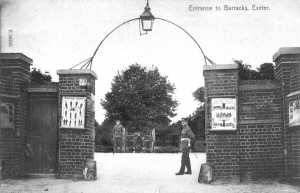Higher Barracks, Exeter
Richard Parker, 2007. https://doi.org/10.5284/1000281. How to cite using this DOI
Data copyright © Exeter Archaeology unless otherwise stated
This work is licensed under the ADS Terms of Use and Access.
Primary contact
Dr
John
Allan
Exeter Archaeology
The Custom House
The Quay
Exeter
EX2 4AN
England
Resource identifiers
- ADS Collection: 752
- DOI:https://doi.org/10.5284/1000281
- How to cite using this DOI
Introduction

Higher Barracks at Exeter were established in the late 18th century as part of a national scheme to improve military accommodation in response to the threat of an invasion during the French Revolutionary Wars. A site on the outskirts of the city was chosen and surrounded by a perimeter wall, within which an impressive group of buildings was constructed. These included a Regimental Headquarters building, barrack ranges and ancillary structures such as a hospital, canteen, workshops, barns, veterinary stables and a riding school. Following a further invasion scare in 1803 the barracks were enlarged and remained in use as a military installation throughout the 19th and 20th centuries. Unlike many comparable buildings Higher Barracks had survived almost complete until their disuse in 1997. This report describes this important group of buildings and presents the evidence for their function and development recovered during archaeological work prior to their recent redevelopment for housing.





